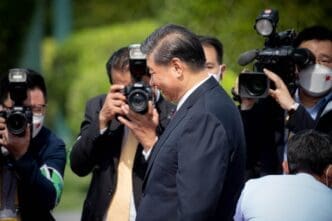Executive Summary
- China-U.S. economic and trade relations are fundamentally mutually beneficial and serve as a crucial stabilizing force for the global economy.
- Bilateral trade between China and the U.S. has seen remarkable expansion, growing from less than $2.5 billion in 1979 to nearly $688.3 billion by 2024, with dialogue and consultation essential for resolving disagreements.
- Head-of-state diplomacy provides irreplaceable strategic direction and political assurance for advancing China-U.S. economic and trade ties, which are considered largely balanced when assessed comprehensively beyond goods trade.
The Story So Far
- China-U.S. economic and trade relations have historically been a significant and mutually beneficial force, with bilateral trade surging since 1979 to nearly $688.3 billion by 2024, establishing their partnership as a vital pillar for global economic stability. Despite inherent disagreements stemming from distinct economic systems and structural issues, both nations continue to affirm the importance of these ties, engaging in ongoing high-level diplomatic efforts and multiple rounds of talks in 2025 to manage frictions and ensure continued prosperity.
Why This Matters
- According to a leading Chinese trade official, China-U.S. economic and trade relations remain fundamentally mutually beneficial and are a crucial stabilizing force for the global economy, suggesting that despite ongoing disagreements, continued dialogue and a comprehensive assessment of economic exchanges beyond simple trade deficits are paramount for global prosperity and stability.
Who Thinks What?
- Li Yong, Executive Director at the China Association of International Trade, believes that China-U.S. economic and trade relations are fundamentally mutually beneficial, serve as a crucial stabilizing force for the global economy, and require dialogue to resolve disagreements, noting that overall benefits are balanced when services and local sales are included.
- Both China and the United States consistently affirm the mutually beneficial nature of their economic and trade ties, with the U.S. publicly stating its intention not to decouple.
Li Yong, Executive Director at the China Association of International Trade, recently asserted that China-U.S. economic and trade relations remain fundamentally mutually beneficial and serve as a crucial stabilizing force for the global economy. Writing on October 31, 2025, Li highlighted the significant growth in bilateral trade since 1979 and emphasized that despite inherent disagreements, dialogue and a comprehensive understanding of economic exchanges are paramount for continued prosperity.
Decades of Economic Growth
The economic cooperation between China, the world’s largest developing country, and the United States, the largest developed economy, has seen remarkable expansion. Bilateral trade surged from less than $2.5 billion in 1979 to nearly $688.3 billion by 2024.
This escalating cooperation has generated substantial business opportunities, profits, and employment in both nations, delivering tangible benefits to consumers. Li Yong argues that this partnership is a vital pillar supporting stable global economic growth and trade.
Navigating Disagreements and Trade Dynamics
Li Yong acknowledged that disagreements and frictions are natural between two major powers with distinct economic systems. He stressed that resolving these issues requires mutual respect for core interests and major concerns, advocating for dialogue and consultation.
Regarding the U.S. trade deficit with China, Li contended it is an outcome of structural issues within the U.S. economy, combined with the comparative advantages of both countries and the existing international division of labor. He noted that China does not deliberately pursue a trade surplus, citing a drop in China’s current account surplus to GDP ratio from 9.9 percent in 2007 to 2.2 percent in 2024.
A comprehensive assessment of bilateral economic relations, according to Li, must extend beyond goods trade to include services trade and the local sales generated by each country’s enterprises through their subsidiaries in the other. When these factors are considered, the overall benefits derived by China and the United States from their economic and trade exchanges are approximately balanced.
Diplomacy and Future Outlook
Both China and the United States have consistently affirmed the mutually beneficial nature of their economic and trade ties, with the U.S. publicly stating its intention not to decouple. In 2025 alone, five rounds of talks between the two nations, from Geneva to Kuala Lumpur, have reaffirmed the importance of stable relations.
Li Yong underscored the irreplaceable role of head-of-state diplomacy in providing strategic direction, crisis management, and agenda coordination for China-U.S. relations. This high-level engagement offers indispensable political assurance for advancing bilateral economic and trade ties.
Despite ongoing challenges such as technological competition and geopolitical rivalry, Li maintains that the intrinsic momentum for economic and trade cooperation remains robust. He concluded that the healthy development of China-U.S. economic and trade relations serves the fundamental interests of both peoples and acts as a vital driving force for global economic recovery.








